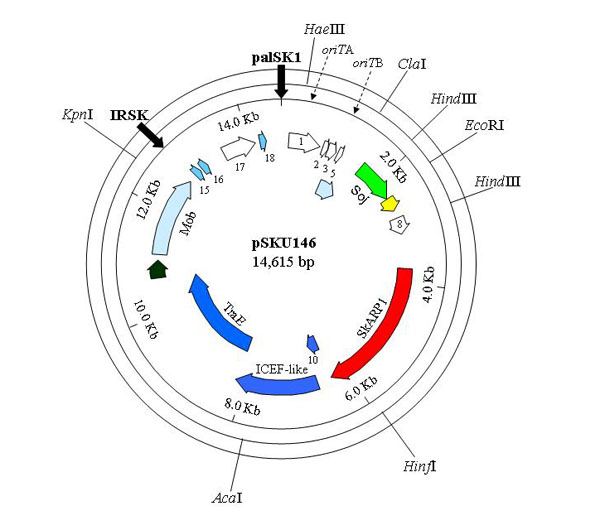
Diagram of plasmid pSKU146 shows potential protein coding regions (arrows) and recognition sites for selected restriction enzymes
BIOL 1406
PreLab 9a.2
How are vectors used in gene cloning?
 |
Gene cloning is a method for making many identical copies of a gene by inserting the gene into a living host cell. Under appropriate conditions, the host cell will replicate the “foreign” DNA along with its own DNA whenever it divides. With each cell division, the number of copies of the “foreign” gene doubles. This technique permits biologists to produce large quantities of a single gene so that they can study the gene in detail. Biologists can also induce cells containing cloned genes to produce large quantities of the protein coded for by the gene. By making large amounts of “proteins to order” in this way, scientists can study the protein’s structure and function. They can also produce large quantities of a protein for commercial or medical use. For example, scientists can produce proteins that are used as enzymes in commercial food processing techniques or proteins that can be used to treat disease. |
|
Diagram of plasmid pSKU146 shows potential protein coding regions (arrows) and recognition sites for selected restriction enzymes |
|
Vectors are tools used by molecular biologists to insert genes or pieces
of foreign DNA into host cells. Two naturally occurring vectors that are
used to insert foreign DNA into bacterial cells are bacteriophages and
plasmids.
Bacteriophages (or phages, for short) are viruses that infect bacterial
cells by injecting their genetic material into the bacterial cell.
Plasmids are small circles of DNA that are sometimes present in bacteria
in addition to the larger circle of DNA that constitutes the main bacterial
genome. Many bacteria readily absorb plasmids from the environment under
appropriate conditions. In order to use a phage or plasmid as a vector,
scientists combine the DNA they wish to clone with the DNA of the vector.
When DNA from 2 different sources is combined, the resulting DNA is called
recombinant DNA. If recombinant DNA gets inside a host cell, it can
replicate along with the DNA of the host cell. In this lab you will be working with a plasmid called pUC18. This plasmid includes 2 genes. One gene confers resistance to the antibiotic ampicillin. Bacteria that contain this gene are able to grow in the presence of ampicillin, while bacteria that lack this gene are not. The second gene is called the lacZ gene. The lacZ gene codes for β–galactosidase, an enzyme normally used by E. coli to digest lactose. However, when bacteria with this gene are grown in a medium containing a synthetic analog of lactose called Xgal, the enzyme digests Xgal and releases a blue compound. Therefore, bacteria with a functional lacZ gene will produce a blue color when grown in the presence of Xgal. |
|
|
Diagram of a bacteriophage |
The following procedure describes how scientists can use pUC18 as a vector to insert phage DNA into E. coli cells:
 |
 |
a) E. coli cells that absorbed no DNA at all, as well as those that absorbed only phage DNA (combinations B and E above) will lack the gene for ampicillin resistance (present only on the plasmid.) Therefore, these bacteria will not grow and no bacterial colonies will be formed.
b) E. coli cells that absorbed only plasmid DNA (combinations A and D above) will have the gene for ampicillin resistance and the lacZ gene. The gene for ampicillin resistance allows them to grow and form colonies. The lacZ gene produces β–galactosidase which digests Xgal and releases compound “X”, which is blue. Therefore, these E. coli cells will produce blue colonies.
c) E. coli cells that absorbed a recombinant plasmid (combinations C above) will have the gene for ampicillin resistance (present on the plasmid.) Therefore they will grow and produce colonies. However, the lacZ gene on the plasmid has been cut into 2 pieces by the restriction enzyme and a piece of phage DNA has been inserted between the 2 parts of the lacZ gene. This inactivates the lacZ gene, meaning no β–galactosidase will be produced. Therefore, Xgal is not digested, no blue color is produced, and the colonies remain white.
|
Use the interactive exercise below to learn how foreign DNA can be inserted into a plasmid. |
|
|
| Your Turn | |
| What is gene cloning?
|
Check your answer. |
| Under ideal conditions the bacterium E. coli can undergo binary fission every 20 minutes. If one E. coli cell containing a foreign gene is inoculated into a flask of nutrient broth and allowed to replicate for 12 hours, how many copies of the foreign gene would it produce? | Check your answer. |
| Why are scientists interested in cloning genes? | Check your answer. |
| Name and describe 2 vectors that are
commonly used to insert foreign DNA into bacterial cells.
|
Check your answer. |
| What is recombinant DNA?
|
Check your answer. |
| Briefly explain how scientists can produce recombinant DNA. | Check your answer. |
Close this browser window to return
to Blackboard and complete the practice quiz and assessment quiz.